A Sense of Place
A photographic essay linking location, community and campus in the Copper Country |
Town and Gown
Copper mining has left an indelible stamp on the Keweenaw even though Calumet & Hecla closed its doors forever in 1968. But copper wasn’t the only profitable resource found in the Upper Peninsula. Timber and sandstone were also exported in quantity, and countless business enterprises have contributed to the development of the region. Michigan Tech students, once known as “toots,” have been an integral part of the community for over one hundred years. Life in the Copper Country continues to thrive and change, yet retains its unique character.
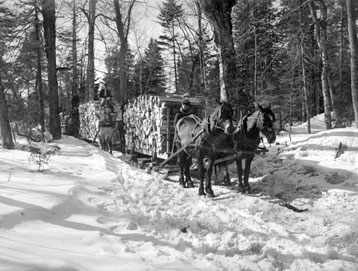
Hauling Lumber by Horsepower (J.T. Reeder)
Reeder Photographic Collection
MS261-028-017-001
|
|
Lumbering was one of the earliest and most important industries in the Keweenaw, and continues to be one of the Upper Peninsula’s main industries. Wood was used for building material and for fuel. Massive timbers were used as stulls, underground support for the hanging rock face left when miners extracted the copper-bearing ore. Early industrial structures such as shaft houses were made of wood rather than metal, and housing was needed for the many workers employed by the mines. Lumbermen produced thousands of feet of dimensional lumber from local timber that was then sold to builders for stores and residences throughout the area. In a horse-powered world it was easier to transport heavy logs over snow than mud, and loggers took advantage of the long Copper Country winters. This photograph was taken in on March 29, 1904, and snow still lies deep beneath the trees. |
Another sought after local building material was stone. Occurring along the eastern side of the Keweenaw Peninsula, sedimentary deposits of what came to be known as Jacobsville sandstone caught the eye of English stonemason George Craig. The Portage Entry Quarry operated several quarries in the Keweenaw, carving out blocks of sandstone that were used in commercial and residential buildings throughout the United States. Many of these grand and stately buildings still stand today, enduring monuments to the labor of the Finnish quarrymen of Jacobsville. |
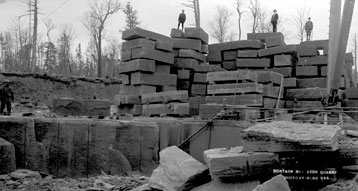
Jacobsville Sandstone Quarry (Adolph Isler)
Roy Drier Photographic Collection
Neg 00424
|
|
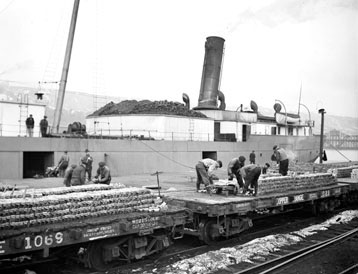
Loading ingots at the Copper Range dock, Houghton
Reeder Photographic Collection
MS042-059-999-Z-31B
|
|
The Portage Lake Shipping Canal was a busy artery for shipping goods and materials in and out of the Copper Country. Smelted copper was cast into ingots and shipped to manufacturers, where the metal was used in the production of electrical wire, hammered into sheets that sheathed ships’ hulls and the roofs of buildings, or alloyed it with other metals to create brass and bronze. The completion of the canal in 1873 shortened the trip across Lake Superior by 170 miles, saving the mining companies time and money. |
Railroads transformed the lives and work of Copper Country residents and businesses. Mining companies moved copper by rail from mine to mill to port, and the narrow gauge Mineral Range Railroad carried passengers between Hancock and Calumet in the 1870s, but all goods, traffic, and communication in and out of the Keweenaw came to a standstill when frozen Lake Superior locked out ships from area ports. In 1883, Houghton was connected by rail to the outside world through the Duluth, South Shore & Atlantic Railroad. Even so, weather still had the power to stop the trains, at least temporarily. Huge plows were mounted on locomotives to clear the renowned Copper Country snows from the tracks. Houghton County saw the end of the line in 1982 when the Soo Railroad Company abandoned use of the last of its Copper Country tracks. Today, freight trains come only as far as Baraga, some 30 miles away. |
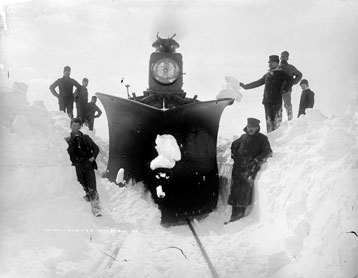
Clearing the tracks of the Hancock & Calumet Railroad (Adolph Isler)
Roy Drier Photographic Collection
Neg 00574
|
|
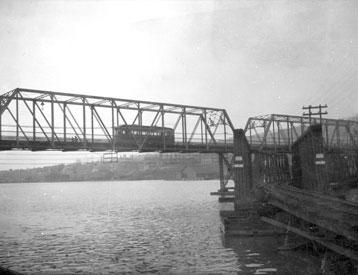
An electric street car crosses the Portage Lake Bridge
William Nara Collection
Nara 42-101
|
|
For thirty-one years, electric streetcars moved people around the Copper Country, from Houghton and Hancock to Lake Linden, and as far north as Mohawk. The Houghton County Traction Company opened for business in November 1900, and by 1910 operated 35 cars over 32 miles of track. Following World War I, the number of passengers using the streetcars steadily declined. Faced with the widespread economic pressures of the Great Depression and increased competition from automobiles, the company made its last streetcar run from Calumet to Hancock on May 21, 1932. |
The 23-mile-long Keweenaw Waterway is a navigational shortcut that was built to allow ships to shorten their journey across Lake Superior and also to provide shelter from that lake’s sometimes tempestuous waters. Early efforts to dredge and straighten the Portage River enabled the first lake steamer to enter the waterway from the south in 1860. Subsequent work resulted in a channel at the north entry, effectively opening the shipping canal from end to end in 1873. The United States government purchased the waterway in 1891 and it has been overseen by the U.S. Army Corps of Engineers since that time. |
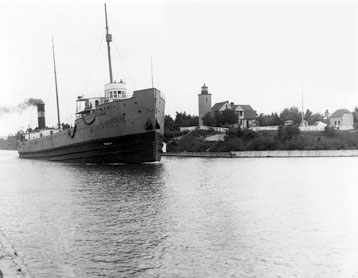
An ore ship leaves Portage Canal
Copper Country Photo Files
Neg 01371
|
|
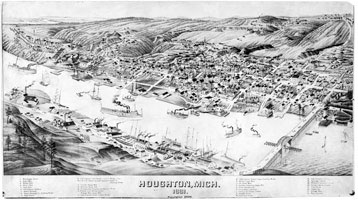
Birdseye of Houghton, 1881
Archives Map Collection
Neg 02605
|
|
Panoramic or “bird’s eye” view maps were an artistic depiction of a town specifically intended to show the place in a positive light. Marketed to civic groups and businessmen, bird’s eye views reflected an idealized version of a place, intended to inspire pride and to encourage investment in what appears to be a flourishing endeavor. Though often quite accurate in structural detail, bird’s eye views tend to exaggerate industry and improvements. This representation of Houghton was drawn in 1881, the decade which marked the height of popularity for panoramic views. It shows an orderly town and a remarkable amount of water traffic, symbolic evidence of Houghton’s prosperity and promise. |
Once the thriving center of Hancock, Tezcuco Street boasted docks and a railroad stop where the street ran down to Portage Lake. Stories from the earliest mining days suggest that many a miner celebrated payday at one of the drinking establishments at the top of Tezcuco Street and worked his way down, stopping only when his pockets were empty and paycheck was spent. This 1911 image of the block of Tezcuco below Quincy Avenue shows a much more respectable scene. Still unpaved a decade into the 20th century, the street features sidewalks for pedestrian traffic. Few of the buildings in this photograph remain standing a century later. |
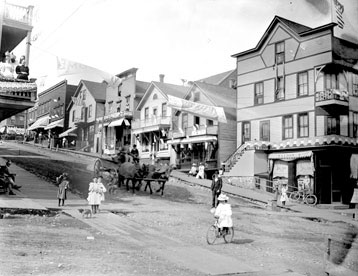
Tezcuco Street, Hancock, 1911
Roy Drier Photographic Collection
Neg 00252
|
|
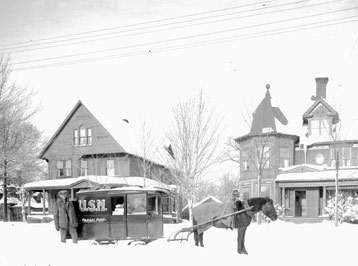
A horse drawn mail car on College Avenue, Houghton, 1924
Reeder Photographic Collection
MS042-999-44-U9B
|
|
Snowy streets have been part of the routine for Copper Country postal workers since the Houghton Post Office was established in 1852. The earliest mail deliveries to the Keweenaw mining district were made by ship in the summer and dog sled once the lake ports closed for the winter. By 1924, when this photograph was taken, Houghton was accustomed to regular and dependable mail service. Photographer J.T. Reeder’s turreted home on College Avenue is featured in the background, one of the many grand homes that once lined that street. |
The old and the new exist side by side in this photograph of downtown Houghton in the 1970s, but even this scene belongs to the past. All of the establishments pictured in these few blocks of Shelden Avenue have closed or relocated. Although building facades and companies have changed, the City of Houghton takes pride in its heritage. The first building on the future town site was erected by Ransom Shelden in 1852, and the town was incorporated nine years later. Today visitors can enjoy a historic walking tour of the City and learn about how the town has changed over the past century and a half. The Michigan Tech Archives continues to collect and document the ongoing development and rich culture of the region. |
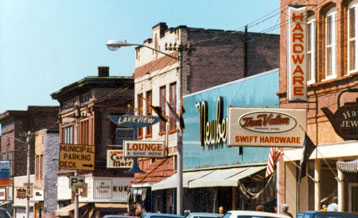
Shelden Avenue, Houghton, in the 1970s
Copper Country Photo Collection
2008-03-27-02
|
|
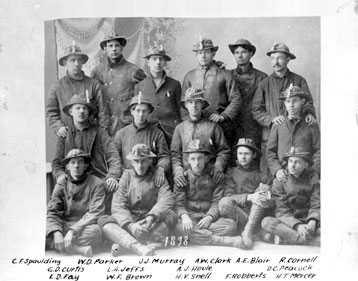
Mining engineering students at the Michigan College of Mines
MTU Photograph Collection
2007-12-15-001
|
|
Michigan Tech has undergone several name changes since its establishment in 1885, but the institution’s reputation for providing hands-on learning remains a constant hallmark. Young men studying for a degree in mining engineering received practical experience as well as classroom education. This group of students is prepared to carry out underground surveying in one of the area’s many mines. In 1898, that meant work was done by candlelight and safety equipment was rudimentary at best. Then, as now, Michigan Tech graduates were shaped by the institutional emphasis of excellence in education. |
The campus has welcomed international students since 1888, when the Michigan Mining School admitted a student from Toyotsu Buzen, Japan into a non-degree program of special studies. The Chinese Club was organized in 1916 to support fellow students in achieving their educational goals. The inaugural edition of the Keweenawan, the 1924 yearbook, explains that many of Tech’s Chinese students came from Tsing Hua College in Peking to study engineering in the United States. Said one club member, “I am going to obtain the best foundation that I can.” |
|
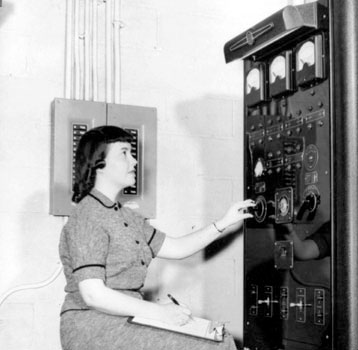
A Michigan Tech student working in a lab
MTU Photograph Collection
Neg 02912
|
|
When this picture was taken in 1952, coeds on campus were nothing new. Margaret McElhinney and Mary Bunce were the first women to enroll at Michigan Tech, joining their male colleagues for classes in science and engineering in 1889. Margaret R. Holley was the first woman to complete a degree program at Tech, earning a Bachelor of Science in General Science 1933, and another in chemistry the following year. In 1952 male students outnumbered female students by more than ten to one. Today, women make up about one fourth of the student body. |
End of the year exam week can be stressful, but these Michigan Tech students took some time to relax by driving a jeep into Douglass Houghton Hall. The oldest residence hall on campus, Douglass Houghton Hall was opened to students in the fall of 1939. Residents paid $9 a week for a two-person room and board. The college provided blankets and linens and for a few years in the 1950s boasted a “first class” barbershop in the building as a time-saving convenience for students. The University administration still discourages the parking of vehicles indoors. |
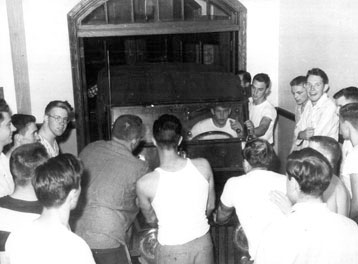
Student antics in Douglass Houghton Hall
MTU Photograph Collection
Acc-05-023D-001
|
|
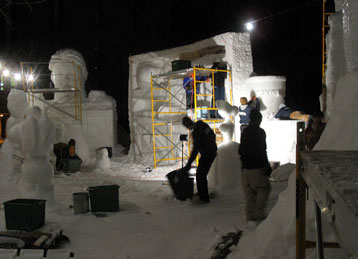
Sigma Phi Epsilon snow statue team
Statue “Toy Story”
2006 Winter Carnival
Neg 02912
|
|
Winter Carnival 2006, “Cartoon Art for the Young at Heart,” was a record breaking event at Michigan Tech. Students celebrated the annual homage to ice on a grand scale by setting three official Guinness world records: World’s Largest Snowball, World’s Largest Snowball Fight, and World’s Large Group Snow Angel. Students design and build snow statues for the week-long event, working at a fevered pitch through the final night to finish in time for the early morning judging. Above, students work on the “Toy Story” statue. This picture is dedicated to Michigan Tech student and Sigma Phi Epsilon brother Jonathon DeCleene (1984-2007), who was a dedicated student assistant in the Archives. |
|

